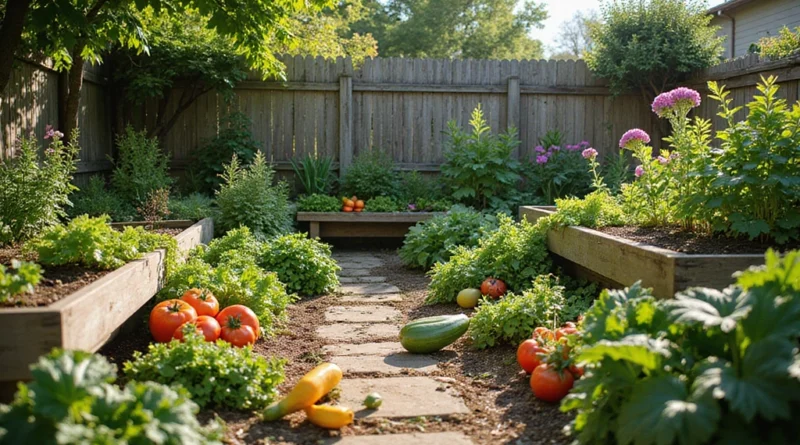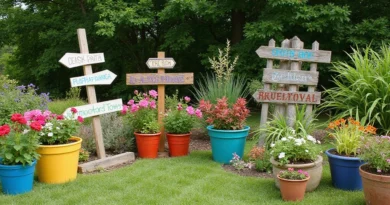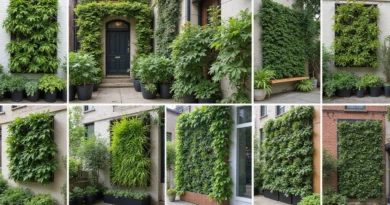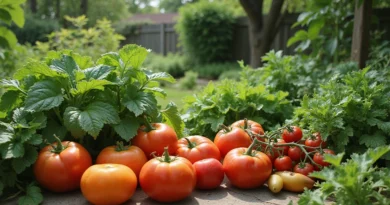25 Brilliant Vegetable Garden Ideas That’ll Transform Your Backyard into a Food Paradise!
Imagine stepping outside into your backyard and being greeted by a vibrant explosion of colors and scents straight from nature.
Creating a vegetable garden is not just about growing food; it’s about embracing a lifestyle that touches all your senses.
From rustic wooden planters filled with lush greens to vertical gardens that sprout in even the tiniest of spaces, there are endless ways to cultivate your own edible paradise.
This list of 25 vegetable garden ideas is designed to inspire you to roll up your sleeves and dig into something special. Whether you have ample room or only a small balcony, there’s a perfect idea waiting for you to make it your own.
1. Raised Garden Beds

Raised garden beds are the ultimate solution for creating a structured and efficient gardening space.
These beds not only make planting easier on your back, but they also allow for better soil drainage and fewer weeds. With the ability to customize the size and shape, you can create a unique gardening layout that fits your style.
Consider filling your raised beds with rich, organic soil to provide the perfect environment for your crops. You can mix vegetables like tomatoes, peppers, and herbs in one bed for a colorful display.
for creating raised beds include using untreated wood to avoid chemicals leaching into your soil and lining the bottom with landscape fabric to prevent weeds. Have fun experimenting with different layouts!
They can be painted or stained in fun colors to add a pop of pizzazz to your garden area.
Be mindful to position them where they get ample sunlight without any obstructions.
2. Vertical Gardens

If space is your enemy, vertical gardens are your best friend.
These gardens utilize wall space to grow a variety of vegetables and herbs, making them perfect for patios or small backyards. You can create a stunning living wall by using wooden pallets or hanging planters filled with trailing vegetables like cherry tomatoes and green beans.
This method also adds layers of interest to your garden. Not only do they save space, but they can also improve air circulation and light exposure for each plant.
To build your vertical garden, start by securing your planters on a wall or fence, ensuring they receive adequate sunlight. Be sure to water them regularly, as vertical gardens can dry out faster.
Experiment with different plant combinations and colors for a visually stunning effect. The key is to mix in some herbs for fragrance and usability as well!
3. Container Gardening

Container gardening is a fantastic way to grow your vegetables if you’re short on space or soil quality.
Using pots and containers allows you to plant virtually anywhere: balconies, patios, or even small side yards. You can choose from traditional terracotta pots to modern, colorful plastic containers, depending on your style.
Look for vegetables that thrive in containers, like lettuce, radishes, and herbs. Consider grouping several pots together for a vibrant display.
Make sure your containers have good drainage to keep your plants healthy. Regular watering is essential as container plants tend to dry out quicker than those in the ground.
Add some colorful flowers to attract pollinators and enhance the visual appeal of your garden. With a little creativity, your container garden can be as beautiful as it is productive!
4. Herb Spiral

Herb spirals are not just functional but also a stunning centerpiece for any garden.
This unique design combines vertical and horizontal gardening, allowing you to plant various herbs in a spiral formation, which offers different microclimates for each herb’s needs.
Constructing an herb spiral requires stones or bricks to create the spiral shape. As you work your way up, use richer soil at the base and lighter soil at the top to accommodate herbs that prefer drier conditions.
Consider planting basil, rosemary, and mint at different levels to maximize space and variety. This approach not only saves ground space but also creates an attractive display that invites both gardeners and guests alike.
Remember to give your herbs enough sunlight, and consider adding a small watering system to keep everything hydrated. Watch as your herb spiral becomes a flourishing oasis!
5. Straw Bale Gardening

Straw bale gardening is a fun, unconventional way to grow vegetables, especially if you have poor soil conditions.
Instead of traditional planting, you use conditioned straw bales as the growing medium. The bales provide warmth and nutrients as they break down, creating a rich environment for your plants.
To start, soak the straw bales for a few days and then plant your seeds directly into the bales. You can grow everything from squash to peppers in this setup.
Straw bale gardening is also a great option for those with mobility issues, as it allows for easy access without bending down. Consider rotating your bales every year to maintain soil health.
Plus, this method creates a unique aesthetic that can draw the eye and spark conversations!
6. Companion Planting

Companion planting is an eco-friendly technique that encourages the growth of beneficial partnerships between plants.
Certain plants thrive when grown alongside others, leading to better yields and protection against pests. For example, tomatoes and basil are a classic duo, as basil can enhance the flavor of tomatoes and deter pests.
Think about how you can incorporate companion planting in your vegetable garden. Create rows or clusters of plants that work well together, like carrots with onions or marigolds with cucumbers.
This method not only makes your garden more productive but also enhances biodiversity. It’s a fun, natural way to maximize space and create a thriving ecosystem.
Remember to research which plants make the best companions, and enjoy watching your plants flourish together!
7. Square Foot Gardening

Square foot gardening is a highly efficient method that maximizes space by dividing your garden into smaller, manageable sections.
By planning out square-foot sections, you can grow different crops closely together while still allowing for ease of access. This technique is perfect for small yards or even community gardens.
Use a grid system to mark out squares, and vary the plants in each section based on their growth requirements. For instance, you might plant lettuce in one square and radishes in another, ensuring that everything is harvested at different times.
This method reduces the need for weeding and watering, as the plants support one another. It’s also an excellent way to teach children about gardening and responsibility.
Consider adding vertical elements to your square foot garden for an even more efficient design!
8. Edible Landscaping

Why not combine beauty with functionality by choosing edible landscaping?
This idea involves incorporating edible plants into your landscape design, allowing you to enjoy aesthetic appeal while growing food. You can line pathways with strawberry plants, use flowering herbs as ornamental border plants, or integrate fruit trees into your yard design.
Think about your favorite edible plants and how they can enhance the visual flow of your space. The vibrant colors of kale, the fragrant blossoms of rosemary, or the lush foliage of blueberry bushes can add layers of interest to your garden.
Make sure to choose plants that thrive well in your climate and consider seasonal variations. This method transforms your garden into a feast for the eyes and the stomach!
Plus, it can help attract pollinators and beneficial insects to your garden.
9. Potager Garden

The potager garden, or kitchen garden, is a stylish way to grow food while maintaining an aesthetically pleasing garden.
This design often includes a mix of vegetables, herbs, and flowers, all growing together in a lush, orderly manner. You can create paths between the beds to enhance accessibility, making it as functional as it is beautiful.
The key to a successful potager garden is diversity. Consider planting colorful blooms alongside your veggies, like zinnias or nasturtiums, to attract pollinators and add visual interest.
Choose a variety of sizes and shapes for your beds to create a dynamic look. It’s a perfect place to experiment with heirloom varieties or fancy greens that you wouldn’t typically find in grocery stores.
This garden showcases your creativity while providing fresh ingredients for your kitchen!
10. Kitchen Table Garden

Bring the garden closer to home by setting up a kitchen table garden right on your kitchen counter!
This trend is all about using small planters filled with herbs or microgreens that you can snip right as you cook. Simple herbs like basil, parsley, or cilantro thrive in this setup and can be grown indoors with plenty of sunlight.
Consider using stylish containers to match your kitchen décor for a beautiful look. These mini-gardens not only save you a trip to the grocery store but also provide you with ultra-fresh ingredients.
This approach is fantastic for those with limited outdoor space or for urban dwellers. Regularly snip the leaves to encourage new growth, and don’t forget to rotate your plants to ensure they get even light.
Your cooking will shine with the added flavor and aroma of fresh herbs!
11. Pollinator-Friendly Gardens

Creating a pollinator-friendly vegetable garden is not just good for the environment but also enhances the productivity of your garden.
By planting a variety of flowering plants alongside your vegetables, you can attract beneficial insects like bees and butterflies. Consider planting nectar-rich flowers, such as sunflowers, bee balm, or lavender, to draw these helpful critters closer to your veggies.
This diversity can lead to better pollination rates for your crops, ultimately resulting in larger yields. Make sure to provide some shelter, like rocks or small logs, for pollinators to rest.
In addition to being functional, a pollinator garden bursts with color and life, making it a vibrant place to spend time. Celebrate the beauty of nature and watch as your garden flourishes with the help of these tiny allies!
12. Winter Gardening

Don’t let winter stop your gardening dreams! With a winter garden, you can grow cold-hardy vegetables like spinach, kale, and carrots even when the temperatures drop.
Using cloches or cold frames can help protect your plants while allowing sunlight to reach them. These structures create a mini-greenhouse effect, providing the warmth needed for growth.
Planting in the fall will give your veggies a head start, and with the right protection, you can enjoy fresh produce throughout the chilly months. Keep an eye on moisture levels, as winter can be dry.
Embrace the beauty of the winter garden with snow-covered plants glistening in the sunlight, proving that gardening is a year-round passion!
13. Community Gardening

Community gardening is a fantastic way to unite neighbors while promoting sustainable practices.
These gardens allow people to come together, share resources, and grow food collectively in a shared space. Whether you have access to a community garden or want to start one, the benefits are endless.
Participants can learn from each other, exchange tips, and grow a diverse range of vegetables suited to all tastes. Plus, it’s also a great way to secure fresh produce without having to maintain a garden on your own.
Consider hosting workshops and events to foster a sense of community and engage everyone. A community garden can be not just a source of food but also a hub for friendship and collaboration.
14. Fruit and Vegetable Combos

Think outside the box by combining fruits with vegetables in your garden.
Planting mounds of strawberries among leafy greens or letting cucumbers climb up a trellis adorned with grapevines can create a unique and productive garden setup. This not only adds visual interest but also maximizes your growing space.
Fruits like berries, melons, and peppers can coexist beautifully, creating an abundance of flavors and textures. This will entice pollinators and make your garden an attractive destination for all sorts of wildlife.
Ensure you research the needs of each plant to keep them thriving together. Explore different heights and colors to create a stunning, bountiful garden!
15. DIY Garden Trellis

Add vertical interest to your garden by building your own trellis.
A trellis not only supports climbing plants like peas and beans but also allows you to create an eye-catching focal point. You can use materials like wood, bamboo, or even repurposed items like old ladders to construct a unique trellis that suits your garden style.
Position your trellis in a sunny area and train your plants to climb it for a dramatic effect. Consider decorating your trellis with hanging planters or colorful vines to increase its visual appeal.
Creating a DIY trellis is a fun weekend project that makes your garden look more organized and professional. Plus, the rewards of homegrown veggies climbing up your beautiful creation will make all the hard work worth it!
16. Succession Planting

Maximize your harvest by practicing succession planting. This technique involves planting new crops as soon as older ones are harvested, allowing you to make the most of your garden space throughout the growing season.
For example, after pulling up early spring radishes, you can plant a second crop like carrots in the same space. This method helps reduce gaps in production and ensures you have fresh veggies at various times throughout the year.
Keep track of planting dates and crop rotation to maintain soil health. By planning ahead, you’ll enjoy a continuous supply of fresh produce from your garden!
17. Natural Pest Control

Sustainability is key in any vegetable garden, and using natural pest control methods can help keep your plants thriving without harmful chemicals.
Introduce pest-repelling plants like marigolds alongside your vegetables to deter unwanted insects. You can also create natural insect traps using soapy water or plant-based oils.
Encouraging beneficial insects, such as ladybugs and lacewings, is another excellent way to maintain a healthy garden ecosystem. Consider planting herbs that attract them, like dill or coriander.
Regularly inspect your plants for signs of pests, and act quickly to address any issues to prevent larger problems. A healthy garden is a happy garden, so embrace these natural methods!
18. Aeroponic Gardening

For those with a passion for innovation, aeroponic gardening allows you to grow plants without soil. Instead, roots hang in the air and are misted with nutrient-rich water.
This method is compact and incredibly efficient, providing optimal growth conditions. Aeroponic systems can be set up indoors or outdoors, making them versatile for any space.
Consider growing fast-growing crops like lettuce or herbs in an aeroponic setup for an impressive yield in a short time. While the initial investment may seem high, the rewards of fresh, clean produce make it worthwhile.
With aeroponics, you can embrace cutting-edge technology while enjoying the fruits of your labor!
19. Rainwater Harvesting

Saving water is crucial, and rainwater harvesting can be an eco-friendly way to keep your vegetable garden thriving.
Install a rain barrel to collect runoff from your roof, and use this water for your plants. This method is sustainable and helps reduce your water bill!
Make sure to place your rain barrel near a downspout and consider a gutter system that directs water efficiently. Regularly check to ensure the barrel stays clean and free of debris.
With rainwater harvesting, you’re not only nurturing your plants but also conserving resources for the environment. It’s a win-win for your garden and the planet!
20. Vertical Hydroponics

Vertical hydroponics combines the best of vertical gardening and hydroponics, allowing you to grow crops without soil using nutrient-rich water in a vertical setup.
This space-efficient method is ideal for urban gardening, maximizing yield in limited spaces. You can build your system using PVC pipes or purchase pre-made hydroponic towers to get started quickly.
Consider planting herbs and leafy greens that thrive in hydroponic systems. This approach can produce faster growth rates and higher yields than traditional gardening methods. Regularly monitor nutrient levels to ensure healthy plant growth.
Imagine having fresh salads or herbs at your fingertips, all while saving space and water—now that’s a modern gardening win!
21. No-Till Gardening

No-till gardening is an eco-friendly method that helps maintain soil structure and health. By avoiding tilling, you preserve beneficial microorganisms and organisms within the soil, promoting a thriving ecosystem.
To start, layer organic materials like mulch or compost on top of the soil instead of digging it up. This technique retains moisture and suppresses weeds while enriching the soil naturally.
You can plant seeds or seedlings directly into the undisturbed soil, allowing them to grow in a stable environment. This method also reduces erosion and minimizes labor, making gardening more accessible for everyone.
Enjoy the beauty of a natural garden that flourishes with minimal intervention!
22. Garden Walkways

Create inviting walkways through your garden to enhance both accessibility and aesthetic appeal. Walkways can help keep soil intact and reduce foot traffic on planted areas, promoting healthier growth.
You can design paths using materials like gravel, wood chips, or even stepping stones, depending on your garden style. Consider weaving your pathways between raised beds or planting areas for a whimsical touch.
Adding edging with small plants or flowers can further enhance the beauty of your garden paths. Not only do they create functional spaces, but they also invite visitors to wander and explore your garden oasis.
These walkways can turn your vegetable garden into a charming retreat, making it a perfect spot for relaxation or entertaining friends.
23. Composting

Composting is an essential practice for any gardener looking to enrich their soil and reduce waste.
By turning kitchen scraps and yard waste into nutrient-rich compost, you’ll create a natural fertilizer for your vegetable garden. Start by setting up a compost bin in a shaded area, and layer green materials (like fruit scraps) with brown materials (like dried leaves) for optimal decomposition.
Regularly turning your compost helps aerate it and speeds up the breakdown process. Once it’s ready, mix the compost into your garden beds to enhance soil quality. Not only will your vegetables thrive, but you’ll also be doing your part for the environment.
Embrace the cycle of nature and watch your garden flourish with the help of your homemade compost!
24. Gardening for Wildlife

Creating a garden that attracts wildlife is a wonderful way to foster biodiversity and help the ecosystem.
Plant native species that provide food and shelter for local wildlife like birds, butterflies, and beneficial insects. Incorporate a mix of flowers, shrubs, and trees alongside your vegetables to create a balanced environment. Consider adding birdhouses or bee hotels to encourage wildlife visits.
This approach not only enhances the beauty of your garden but can also improve pollination rates and pest control. Celebrate nature in your garden by welcoming these creatures while enjoying the benefits they bring to your plants.
Your garden can become a haven for wildlife, proving that gardening is more than just growing food—it’s about building a community.
25. Seasonal Planting Calendar

To keep your vegetable garden thriving year-round, create a seasonal planting calendar.
This tool helps you plan when to plant, transplant, and harvest different crops based on your local climate. By scheduling your planting, you can maximize yields and ensure you always have something fresh growing in your garden.
Include crop rotation strategies to maintain soil health and prevent pests. You can track important dates for planting, watering, and fertilizing, making gardening easier and more organized. This approach creates a structured environment for your plants and saves you from last-minute planting decisions.
Enjoy a productive garden throughout the year by keeping your planting calendar handy!
Conclusion

Transforming your backyard into a vegetable paradise is not just an endeavor; it’s a journey full of discovery and joy.
Whether you opt for traditional gardening or modern techniques, there are countless ways to grow your own food and bring beauty to your outdoor space.
Dive into these ideas, embrace your creativity, and take the first steps toward cultivating your personal food oasis!



